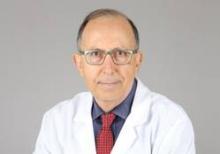SAN DIEGO – Electrical stimulation therapy of the lower esophageal sphincter is effective for treating refractory gastroesophageal reflux disease, according to interim results from a trial presented at the annual meeting of the American College of Gastroenterology.
A total of 32 patients underwent implantation of a pair of electrodes in the muscular layer of the gastroesophageal junction. The electrodes were connected to a pulse generator in the abdomen that delivered intermittent stimulation.
Six months later, the patients had a sustained, more than one-half reduction from baseline in exposure of the esophagus to acid and a two-thirds reduction in symptoms, reported first author Dr. Edy E. Soffer at the meeting.
Additionally, whereas most of the patients had been taking proton pump inhibitors (PPIs) at baseline, only about 1 in 10 were doing so at 6 months. None experienced any device-related adverse events.
The findings support the effectiveness and safety of electrical stimulation therapy in this population, according to Dr. Soffer, who is a professor in the gastroenterology division, Keck School of Medicine, University of Southern California, Los Angeles.
"Currently, there are ongoing studies, and there will be future sham-controlled studies that should clarify further the role of this intervention in the treatment of GERD [gastroesophageal reflux disease] and its mechanism of action," he noted.
Session attendee Dr. Marcelo Vela of the Baylor Clinic, Houston, noted that earlier studies have shown that this therapy increases basal pressure of the lower esophageal sphincter (LES). "Because the main mechanism for reflux is transient LES relaxations [TLESRs], particularly with small hernias as in your patients, do you have any data on TLESRs?" he asked.
"No, LES pressure was not an endpoint in these studies," Dr. Soffer replied. "Initially, we thought that this [basal pressure] is the main mechanism; as we are learning more, it is probably not going to be the main mechanism. We are looking at others, including TLESRs. ... We don’t have data yet."
Dr. Joel Richter, of the University of South Florida, Tampa, wondered whether patients experienced any of the oft-feared complications of antireflux surgery, such as bloating, diarrhea, and dysphagia.
"There were only two cases of dysphagia, and they basically resolved on their own," Dr. Soffer replied. "We didn’t see any of the symptoms that you see with postsurgical therapy. ... The intervention really should not result in the symptoms that come after standard surgical care."
Dr. Richter also requested more information on hiatal hernia repairs undertaken in some patients. "If you had a hernia repair, how do you know what part of the success was related to the hernia repair versus the stimulation?" he asked.
Thirteen patients had a hernia repair, with technique left up to the treating physician, Dr. Soffer replied. "We will look separately, when we complete that phase, at those that had the hernia repair versus those that did not."
"Was there a bit of a trend toward any improvement depending on your hernia size?" Dr. Richard McCallam of Texas Tech University in El Paso asked, while also noting that patients with hernias measuring 3 cm or more were excluded.
There were too few patients to assess trends, according to Dr. Soffer. "We tried not to take patients who had particularly severe disease at the beginning," he added. "The 3-cm hernia repair will be the one perhaps that will need to be looked at more carefully. This is a more sustained hernia situation as compared to the 1- and 2-cm [ones]."
The investigators enrolled GERD patients in the study who had a GERD health-related quality of life score of 20 or higher when not taking PPIs, and who had at least a partial response to these agents. They were required to have a basal LES end-expiratory pressure of at least 5 mm Hg, and to have a pH below 4.0 for more than 5% of the time on 24-hour esophageal pH monitoring.
The patients’ mean age was 50 years, and 18 of them were male, according to Dr. Soffer.
The main results showed a sustained reduction in esophageal acid exposure; the percentage of time at pH less than 4.0 was 10.3% at baseline, compared with 3.7% at 3 months (P less than .01), and 4.6% at 6 months (P less than .01).
There was also a sustained improvement in symptoms as assessed from GERD health-related quality of life; the score was 15 at baseline on PPIs and 31 at baseline off PPIs. These figures compared with a score of 4 at 3 months and 5 at 6 months.


